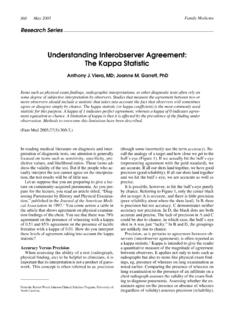Transcription of RAI-MDS 2.0 Quality Indicator Interpretation Guide ...
1 Alberta Health RAI-MDS Quality Indicator Interpretation Guide December 2015 Table of Contents Introduction .. 1 About RAI-MDS Quality Indicators .. 3 FAL02: Falls in the Last 30 Days in LTC .. 5 PRU06: Worsened Pressure Ulcer in LTC .. 7 DRG01: Potentially Inappropriate Use of Antipsychotics in LTC .. 9 RES01: Restraint Use in LTC ..11 ADL05: Improved physical Functioning in LTC ..13 ADL5A: Worsened physical Functioning in LTC ..15 MOD4A: Worsened Depressive Mood in LTC ..18 PAI0X: Experiencing Pain in LTC ..20 PAN01: Experiencing Worsened Pain in LTC ..22 Alberta Health RAI-MDS Quality Indicator Interpretation Guide December 2015 2015 Government of Alberta 1 Introduction The Ministry of Health developed and maintains the Alberta Continuing Care Information System (ACCIS) which captures the International Resident Assessment Instrument Minimum Data Set ( RAI-MDS ) assessments for Alberta s long-term care (LTC) population.
2 ACCIS also submits this RAI-MDS assessment data to the Canadian Institute for Health Information s (CIHI) Continuing Care Reporting System (CCRS). Through complex algorithms, data from the RAI-MDS assessments are used to develop RAI-MDS Quality indicators and outcome measures. RAI-MDS Quality indicators are measures of health processes and outcomes in LTC that identify potential areas for Quality improvement. In June 2015, CIHI launched public reporting for an expanded set of RAI-MDS Quality indicators which report results at the national, provincial, health zone and facility levels. These results are accessible at using the search function within the In Depth section.
3 To facilitate the understanding and Interpretation of the nine publicly reported Quality indicators for LTC, this Interpretation Guide was developed to provide information on each Quality Indicator including: The Indicator name and code; The calculation of the Indicator with inclusion and exclusion criteria; A graph showing Alberta s performance from fiscal years 2010/11 to 2013/14; An representation of Alberta s performance compared to the national average in 2014/15; Context for the Indicator , including definitions where applicable; and, Interpretation notes, including initiatives and considerations. Alberta s performance compared to the national average in 2014/15 is identified through graphics beside the graph of Alberta s performance for each Quality Indicator .
4 The graphics display the national average in a coloured box. Green represents that Alberta s performance is more desirable than the national average. Grey represents that Alberta s average is statistically similar to the national average. Red represents that Alberta s performance is less desirable than the national average. This Guide can be used by anyone seeking a general understanding of Quality indicators, from members of the public to individuals working in LTC facilities, members of Alberta Health Services and the Ministry of Health. For More Information This Guide is available through the Ministry of Health s website at For more details on Alberta Health Services zone-level performance and initiatives related to the QIs, please visit Alberta Health Services website More Desirable Same as Average Less Desirable Alberta Health RAI-MDS Quality Indicator Interpretation Guide December 2015 2015 Government of Alberta 2 at and click on the Continuing Care Quality Indicators link under the Performance section.
5 For more information on Quality indicators, contact the Continuing Care Branch at Alberta Health at 780-644-5499 (dial 310-0000 for toll-free access within Alberta). Alberta Health RAI-MDS Quality Indicator Interpretation Guide December 2015 2015 Government of Alberta 3 About RAI-MDS Quality Indicators Quality indicators (QI) are measures which flag potential Quality issues that may need further review and investigation. They are used for a variety of purposes, including by care providers to monitor trends and improve care, by governments to monitor care, and for public reporting. There are two types of RAI QIs: prevalence indicators and incidence indicators.
6 Prevalence indicators represent the proportion of residents who are assessed as presenting with a condition/event of interest at a single point in time. Prevalence indicators do not include admissions assessments in the calculation of the QI. Incidence indicators represent the proportion of residents with a new presentation of the condition/event of interest which compares two points in time. Incidence indicators do include admission assessments in the calculation of the QI. QIs may be reported as unadjusted or risk adjusted. Unadjusted QIs reflect the percentage of a discrete resident population within a LTC facility that have triggered the QI (see calculation), enabling facilities to trend Quality measures to compare performance changes within their facility over As not all facilities care for the same cohorts of residents, risk adjusted QIs take into account the differences in resident characteristics that are outside of the control of a facility and are known to affect Indicator results.
7 Defensible risk adjustment methodologies, developed through interRAI, are applied to raw Indicator scores to permit appropriate and fair facility-to-facility comparisons. The risk adjustment process allows for comparability between different facilities. A detailed description of the risk adjustment process can be found on the CIHI website: QIs are presented as a percentage for a fiscal year or a fiscal quarter. They are derived based on the coding of the RAI-MDS assessment which is a point in time assessment. To calculate a fiscal-year average, four RAI-MDS assessments per client, per fiscal-year (the most recent assessment for each of the four adjacent fiscal-quarters) are used if those assessments meet the inclusion criteria for the given QI (also known as rolling quarters ).
8 A detailed description of the rolling quarters calculation can be accessed at Accessing Indicator Results Reports for adjusted and unadjusted QIs can be accessed through ACCIS (Ministry of Health), and through the CCRS eReports (CIHI). A designate from each LTC facility in Alberta has access to the reports available through ACCIS and CCRS eReports. Slight differences in QI values may be noted between CCRS and ACCIS data reports. This is a result of slight variations between the two systems in the calculation of QIs, record inclusion/exclusion criteria, time of report runs, and more. Please note that when using the CCRS eReports to compare Alberta s QIs to other provinces, ensure that Residential is selected and not Hospital-based for the Quality Indicator Trend criteria.
9 Alberta Health RAI-MDS Quality Indicator Interpretation Guide December 2015 2015 Government of Alberta 4 Source software systems ( MediTech) at LTC facilities only provide unadjusted QI information. Unadjusted rates are best used to compare performance changes within a facility over time but should not be used to compare between facilities. The risk adjustment process allows for comparability between different facilities. Alberta Health RAI-MDS Quality Indicator Interpretation Guide December 2015 2015 Government of Alberta 5 FAL02: Falls in the Last 30 Days in LTC Indicator Name: Percentage of LTC residents who fell in the last 30 days.
10 Indicator Code: FAL02 Calculation The unadjusted QI for a given LTC facility is calculated as follows: % of residents who have had a fall in the last 30 days = Number of residents who had a fall in the last 30 days All assessed residents Unadjusted rates are best used to compare performance changes within a facility over time. The risk adjusted QI is calculated using a predetermined statistical process that adjusts for differences in the populations served and the associated differences in risk that come with various conditions. The risk adjustment process allows for comparability between different facilities. Source: CCRS eReports, September 08, 2015.
















